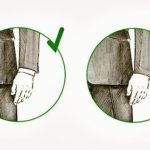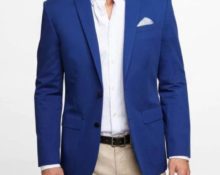A jacket is an attribute of business style. It emphasizes the advantages of the figure and hides its shortcomings, indicates the taste and wealth of a man. But there is only one step from good style to untidiness, and the rules that apply to outerwear of any style will help you avoid it.
How should a jacket fit on a man?
Too long reduces height, short is a sign of bad taste. A wide one makes you look fat and untidy, while a narrow one restricts movement. A properly chosen jacket fits your figure like a glove, without stretching or sagging anywhere. It provides comfort and does not limit mobility. How to achieve this result? You just need to focus on the basic parameters.
By lenght
 The bottom edge of the floor, located at the level of the knuckles of relaxed hands, is considered good form. But if we are not talking about business classics, but about a blazer, then you can focus on the length of the sleeve: not shorter than it.
The bottom edge of the floor, located at the level of the knuckles of relaxed hands, is considered good form. But if we are not talking about business classics, but about a blazer, then you can focus on the length of the sleeve: not shorter than it.
Focusing on the back of the jacket, they often give a recommendation to “close the buttocks,” which is not entirely true, since the maximum possible opening of the leg line allows you to visually adjust a man’s height upward. But the impulse to completely expose his trousers did not find a response in the business world: the skirts necessarily cover the belt, even if the gentleman is sitting down - this is an axiom. So where to look? To the height of the suit.
The optimal, most advantageous option is considered to be a line that conventionally divides the distance from the collar to the bottom edge of the trousers in half.
If the jacket is longer, there is a risk of visually shortening your legs. In short, lengthen your arms. Both options make the silhouette blurry, awkward, and the outerwear looks as if it was taken off someone else’s shoulder.
Shoulder and chest width
 The right jacket should emphasize masculinity, one of the manifestations of which is the size of the shoulders. No drooping or protruding. The collar fits tightly around the neck, and the shoulder seam completely follows the natural contours without going beyond them. If nature has endowed a man with narrow or sloping shoulders, the deficiency is compensated by suitable shoulder pads, the presence of which cannot be guessed without examining the clothes from the inside.
The right jacket should emphasize masculinity, one of the manifestations of which is the size of the shoulders. No drooping or protruding. The collar fits tightly around the neck, and the shoulder seam completely follows the natural contours without going beyond them. If nature has endowed a man with narrow or sloping shoulders, the deficiency is compensated by suitable shoulder pads, the presence of which cannot be guessed without examining the clothes from the inside.
When buying in a store, preference should be given to models that, when fastened, allow the palm to pass between the floors and the torso. In the same case, when you want more freedom of movement and the “ideal” seems to be a stock that allows the fist to pass through, it is better to turn to tailors - they will be able to realize your plans without compromising the silhouette.
Sleeve length
A jacket that covers the wrist but leaves the hand free is a requirement of business etiquette.
 The base of the hand, or more precisely, the area of the wrist joint, is the lowest point of the jacket sleeve on the relaxed arm. This is approximately 1-2 cm above the line outlined by the edge of the cuff of a properly fitted shirt.
The base of the hand, or more precisely, the area of the wrist joint, is the lowest point of the jacket sleeve on the relaxed arm. This is approximately 1-2 cm above the line outlined by the edge of the cuff of a properly fitted shirt.
By silhouette
No sagging, protruding or folds. If the requirement is met along with the wishes for shoulder width, fit and length, the jacket is chosen correctly. When viewed from the side, special attention should be paid to the slots, if they are provided. An open cut indicates excessively tight clothing.
IMPORTANT INFORMATION! A fitted jacket favorably emphasizes the advantages of the figure of thin men. If you have an athletic build, a semi-fitted jacket will provide sufficient freedom of movement. The shortcomings of a corpulent figure are well hidden by a straight cut.
The most common mistakes, problems with fitting a jacket
Don’t worry if the front is slightly longer than the back - the lateral “horizontalness” is not of fundamental importance. But when viewed from the front or back, the jacket's hems must be at the same level and be symmetrical.
The collar of outerwear must fit to the neck without gaps. The lapels of the jacket are to the sides. If fastening the top button causes them to bulge, then the model is not tailored to your figure.
 The back of a well-tailored jacket is distinguished by the absence of horizontal or inclined folds, indicating excessive tension in the fabric. Vertical waves are acceptable if the outerwear is unbuttoned, but they must disappear when the sides are buttoned. Special attention is paid to the vents: cuts that are open or form a fabric fold not provided for by the design indicate the incompatibility of the silhouette with the figure.
The back of a well-tailored jacket is distinguished by the absence of horizontal or inclined folds, indicating excessive tension in the fabric. Vertical waves are acceptable if the outerwear is unbuttoned, but they must disappear when the sides are buttoned. Special attention is paid to the vents: cuts that are open or form a fabric fold not provided for by the design indicate the incompatibility of the silhouette with the figure.
The sleeves are always straight, without grooves or waves.If the sleeve is deformed under the shoulder seam, then the shoulders of the jacket are too wide. Waves on the back with relaxed arms are a clear sign of improper cut.
Regardless of the number of buttons, the hem of a buttoned jacket should not be stretched. The X-shaped folds found on the abdomen indicate a small clothing size. There are exceptions to this rule, but they are only for thin men. If you are athletic and well-fed, if you encounter such a problem, you should choose a jacket 1-2 sizes larger.


 0
0





